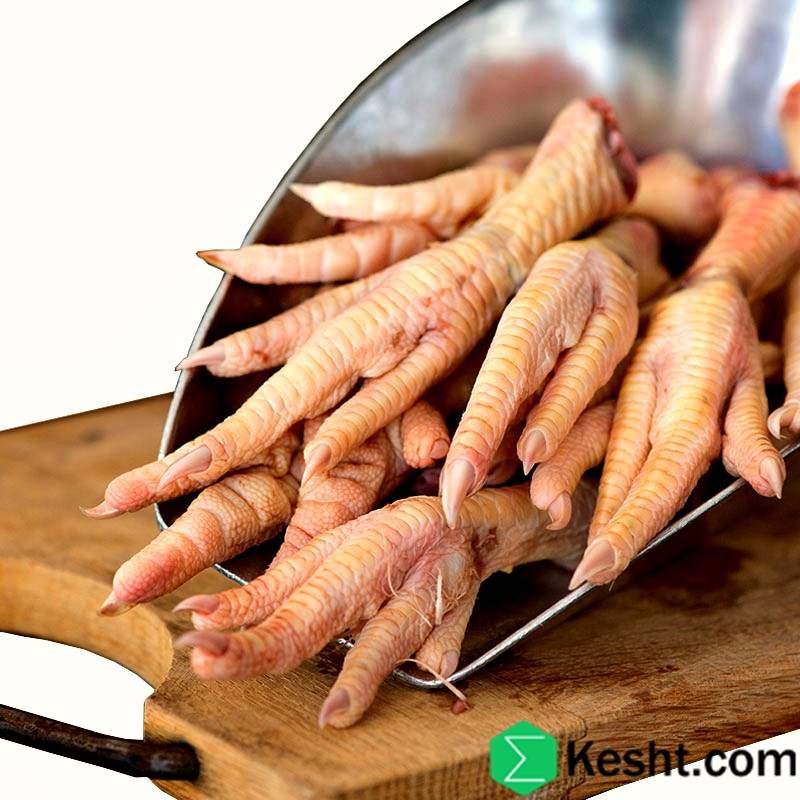### Global Chicken Feet Market and Price, Supply, and Demand Analysis in Different Countries
#### Global Market Analysis and Demand for Chicken Feet
**Market Status:** The chicken feet market is growing due to increased demand for protein products and greater attention to the nutritional value of this item. According to economic data, the export and production of chicken feet in various countries have risen.
**Factors Influencing Demand:**
1. **Lifestyle Changes:** With increased awareness of nutrition and the benefits of chicken feet (such as being rich in collagen and protein), consumers are more inclined to add them to their diets.
2. **Global Food Trends:** The popularity of Asian cuisines and the use of chicken feet in street food and restaurants have contributed to rising demand.
3. **Population Growth:** As the population increases and the need for affordable and nutritious protein sources rises, demand for chicken feet, especially in developing countries, has surged.
#### Major Producing and Exporting Countries of Chicken Feet
- **China:** One of the largest producers and consumers of chicken feet, China also serves as a major exporter to other countries.
- **United States**: The U.S. is also a major producer of chicken feet, playing an important role in the global market.
- **Brazil and Thailand**: These countries are also involved in the production and export of chicken feet, supplying to global markets.
### Trends in the Chicken Feet Market
- **Processed Products**: The demand for processed chicken feet, such as snacks and ready-to-eat meals, is on the rise.
- **Health Awareness**: With increasing awareness about health and nutrition, consumers are seeking healthier and more nutritious protein options.
### Challenges in the Chicken Feet Market
- **Health Regulations**: Different countries have specific laws and regulations regarding the export of chicken feet, which can impact trade.
- **Competition with Other Protein Sources**: Chicken feet compete with other protein sources like beef and fish, which can affect demand.
The global chicken feet market is growing, and due to the increasing demand for nutritious protein products, this trend is expected to continue. However, there are challenges that need to be considered. Overall, chicken feet have established their position in the global market as a valuable and economical food source.
### Impact of Global Chicken Prices on the Chicken Feet Market
Global chicken prices have significant effects on the chicken feet market. Here are various aspects of these impacts:
1. **Pricing and Costs**
- **Increase in Chicken Prices**: When global chicken prices rise, the costs of producing and distributing chicken feet may also increase. This directly impacts the final price of chicken feet and can affect demand.
- **Decrease in Chicken Prices**: Conversely, if chicken prices decrease, production costs for chicken feet might also fall, potentially leading to lower prices for chicken feet and increased demand.
2. **Changes in Demand**
- **Substitution**: If chicken prices rise significantly, consumers may seek alternative options, such as chicken feet, which may be cheaper compared to other parts of the chicken.
- **Impact on Consumer Preferences**: Fluctuations in global chicken prices can lead to changes in consumer preferences, steering them towards consuming chicken feet.
2. **Exports and Imports**
- **International Competition**: Global chicken prices can affect competition among countries. Exporting countries of chicken feet may be influenced by global chicken prices and may alter their export strategies.
- **Impact on Domestic Markets**: If global chicken prices are high, importing countries may seek to source chicken feet from domestic markets, potentially leading to increased demand for chicken feet.
### 4. Trade Policies and Tariffs
- **Tariffs and Regulations**: Changes in global chicken prices may lead to shifts in trade policies and tariffs, which can impact the Import and export of chicken feet.
Overall, global chicken prices act as a significant factor in determining the price and demand for chicken feet. Fluctuations in chicken prices can lead to changes in consumer behavior, business strategies, and international competition, all of which will affect the chicken feet market.
### Influential Factors
In addition to global chicken prices, other factors also impact the chicken feet market. Below are some of these factors:
1. **Economic Factors**
- **Inflation Rate**: An increase in the inflation rate can raise the costs of production and distribution of chicken feet, consequently increasing prices.
- **Consumer Purchasing Power**: Changes in income and purchasing power can affect the demand for chicken feet. During economic downturns, consumers may seek cheaper alternatives.
2. **Social and Cultural Factors**
- **Lifestyle Changes**: Increased awareness of healthy eating and a preference for local and traditional foods can influence demand for chicken feet.
- **Food Trends**: Trends towards specific foods, such as street food or traditional dishes, can impact the popularity and demand for chicken feet.
3. **Health and Safety Factors**
- **Health Regulations**: Changes in food safety and health regulations can significantly affect the production and distribution of chicken feet. Adhering to health standards can increase costs.
- **Health Awareness**: Health concerns and awareness can influence consumer decision-making, especially regarding meat products.
### Environmental Factors
- **Impact of Climate Change**: Climate change can affect chicken and chicken feet production, especially in agricultural areas that depend on poultry feed production.
- **Natural Resources**: Access to natural resources, such as water and land, can influence the production and costs of chicken feet.
### Technological Factors
- **Technological Advances**: Innovations in production and processing methods can help reduce costs and improve the quality of chicken feet, which in turn affects demand.
### Political Factors
- **Political Stability**: The political situation in producing and importing countries can impact trade and market access.
- **Trade Policies**: Tariffs, export and import regulations, and trade agreements can have significant effects on the chicken feet market.
All of these factors, along with the global price of chicken, play a crucial role in shaping and changing the chicken feet market. Understanding these factors can help producers and consumers make better decisions regarding the buying and selling of chicken feet.
### Factors Affecting the Supply and Price of Chicken Feet in the Iranian Market
In Iran, several factors can significantly impact the chicken feet market. Below are some of the most important factors:
Here’s the translation of your text into English:
1. **Economic Factors**
- **Inflation Rate**: Iran faces high inflation rates, which can impact production costs and the final price of chicken feet. Increases in raw material prices and production costs directly affect prices.
- **Consumer Purchasing Power**: Decreased income and purchasing power, especially in difficult economic conditions, can lead to reduced demand for protein products like chicken feet.
2. **Social and Cultural Factors**
- **Lifestyle Changes**: Changes in eating habits and increased awareness of healthy nutrition may alter demand for specific, nutritious foods like chicken feet. Additionally, chicken feet may be considered a cheaper option compared to other chicken parts.
- **Popularity of Traditional Foods**: Chicken feet are used in some traditional Iranian dishes and can be a popular choice for parties and ceremonies.
3. **Health and Safety Factors**
- **Health Regulations**: Adhering to health standards in the production and distribution of chicken feet is crucial. Changes in health regulations can affect supply and demand.
- **Health Concerns**: Awareness of health and food safety can influence consumer decision-making.
2. **Political Factors**
- **Political Stability**: The political and economic situation in the country can affect the market. Sanctions and political instability may have negative impacts on imports and exports.
- **Trade Policies**: Tariffs and regulations regarding imports and exports can influence access to resources and pricing.
3. **Environmental Factors**
- **Climate Change Impacts**: Climate change and environmental issues can affect agricultural production and access to raw materials, which in turn impacts the price and supply of chicken feet.
In summary, economic, social, health, and political factors in Iran are among the most significant influences on the chicken feet market. Understanding these factors can help producers and consumers make better decisions regarding the buying and selling of chicken feet.
### Impact of Reduced Inflation Rate on Chicken Feet Prices
Reducing the impact of inflation on chicken feet prices requires implementing a series of strategies at various levels. Below are some of these strategies:
1. **Improving Production Efficiency**
- **Utilizing Modern Technologies**: Investing in new technologies and improving production processes can help reduce costs and increase productivity.
- **Optimal Resource Management**: Optimizing the use of resources like water and feed can lead to lower production costs.
2. **Diversification in Resource Supply**
- **Developing Supply Chains**: Creating a diverse and sustainable supply chain can help mitigate the impact of raw material price fluctuations.
- **Local Farming and Production**: Encouraging local farming and feed production can reduce dependency on imports and price volatility.
3. **Price Control**
- **Government Policies**: The government can help alleviate inflationary pressures by regulating prices and providing subsidies to producers.
- **Regulations and Oversight**: Monitoring the market and preventing hoarding and unjustified price increases can help maintain price stability.
4. **Education and Awareness**
- **Farmer Education**: Providing necessary training to farmers and producers about best production practices and cost management can enhance quality and reduce costs.
- **Consumer Awareness**: Increasing consumer awareness about product choices and fair pricing can foster healthy competition in the market.
5. **Developing Local Markets**
- **Local Markets and Direct Sales**: Establishing local markets for direct product sales can reduce distribution costs and improve consumer access to chicken feet.
- **Expanding Online Sales**: Utilizing online sales platforms can enhance access and competition in the market.
2. **Long-Term Planning**
- **Sustainable Development Strategies**: Formulating sustainable development strategies in the poultry industry can help reduce volatility and increase price stability.
- **Market Analysis and Forecasting**: Conducting continuous market analysis and forecasting future trends can help producers prepare for changes.
By implementing these strategies, the impact of inflation on chicken feet prices can be mitigated, contributing to market stability and sustainability. These actions require collaboration among the government, producers, and consumers to enhance economic and social conditions.
### Import of Animal Feed
The import of animal feed has a significant impact on chicken feet prices. Below are various aspects of this impact:
1. **Production Costs**
- **Dependency on Imported Feed**: If a country relies on importing animal feed, fluctuations in global feed prices (such as corn and soy) can directly affect the production costs of chicken, and consequently, the price of chicken feet.
- **Increased Costs**: Any increase in animal feed prices leads to higher production costs, which can result in increased prices for chicken feet in the market.
2. **Impact on Supply and Demand**
- **Reduced Supply**: If animal feed prices rise significantly, producers may reduce their output, leading to a decrease in the supply of chicken feet and subsequently an increase in prices.
- **Change in Demand**: Rising prices for chicken feet may lead to decreased demand, especially when consumers seek cheaper alternatives.
3. **Competition with Domestic Production**
- **Impact on Domestic Prices**: The import of animal feed can influence domestic prices. If domestic feed prices are high, imports can help lower costs and prices, while in the opposite scenario, prices may rise.
- **Quality of Feed**: The quality of imported feed can affect the quality and health of the produced chicken, which ultimately impacts demand and the price of chicken feet.
4. **Economic and Political Fluctuations**
- **Sanctions and Restrictions**: When imports of animal feed face sanctions or restrictions, obtaining feed can become difficult and costly, leading to higher prices.
- **Currency Fluctuations**: Changes in exchange rates can affect the price of imported animal feed and, in turn, impact chicken feet prices.
The Import of animal feed acts as a key factor in determining chicken feet prices. Fluctuations in the price and availability of animal feed can have cascading effects on production costs and chicken feet prices. To mitigate these impacts, developing domestic animal feed production and reducing dependency on imports can be an effective strategy.
### Reducing Dependency on Imported Animal Feed
Reducing dependency on imported animal feed is a key objective for enhancing sustainability and self-sufficiency in the livestock industry. Below are some effective strategies to achieve this goal:
1. **Developing Domestic Animal Feed Production**
- **Local Cultivation of Raw Materials**: Encouraging the cultivation of local crops such as corn, soy, and alfalfa, which are used as animal feed. This can help increase production and reduce the need for imports.
- **Utilizing Marginal Lands**: Identifying and utilizing marginal lands for growing forage and animal feed.
2. **Research and Development**
- **Research for Performance Improvement**: Supporting research aimed at improving the performance and quality of animal feed, particularly in the cultivation of plants used as feed.
- **Adopting Modern Technologies**: Utilizing modern technologies in the cultivation and production of animal feed to increase productivity and reduce costs.
3. **Diversity in Feed Sources**
- **Substituting Feed Sources**: Using alternative sources such as agricultural by-products, food waste, and non-food plants that can be used as animal feed.
- **Developing Local Resources**: Using local and drought-resistant plants that can be cultivated as animal feed.
4. **Education and Consultation for Livestock Farmers**
- **Feed Management Training**: Providing necessary training to farmers on optimizing animal nutrition and efficiently using available resources.
- **Consultation on Feed Formulation**: Assisting farmers in selecting and formulating diets that meet the nutritional needs of their livestock.
### Supportive Policies
- **Subsidies and Facilities**: Providing government subsidies and facilities for animal feed producers to reduce costs and encourage domestic production.
- **Investment Support**: Encouraging investment in the animal feed industry through financial assistance and tax incentives.
### Strengthening the Supply Chain
- **Creating a Sustainable Supply Chain**: Strengthening the animal feed supply chain through cooperation among farmers, producers, and distributors.
- **Developing Local Markets**: Establishing local markets for buying and selling animal feed, which can help reduce dependency on imports.
By implementing these strategies, dependency on imported animal feed can be reduced, leading to self-sufficiency in this sector of the livestock industry. These actions not only contribute to increasing economic sustainability but can also improve quality and reduce production costs.
### Chicken Feet Prices in Iran Compared to Other Countries
The price of chicken feet in Iran is influenced by various factors that may make it different from other countries. Below, I will examine some of these factors and compare prices.
### 1. Factors Affecting Chicken Feet Prices in Iran
- **Production Costs**: High production costs, including the price of animal feed, labor, and other expenses, can lead to increased prices for chicken feet in Iran.
- **Inflation Rate**: A high inflation rate in the country can result in rising prices in the food market, including chicken feet.
- **Regulations and Government Policies**: Tariffs, subsidies, and trade policies can significantly impact prices.
### 2. Impact of Local Markets
- **Local Demand and Supply**: The price of chicken feet in Iran is also influenced by local demand and supply. When demand is high and supply decreases, prices may rise.
- **Eating Habits**: Culinary culture and consumer habits in Iran can also affect chicken feet prices.
Overall, the price of chicken feet in Iran may be higher than in some countries and lower than in others due to economic, health, and cultural factors. For a more accurate analysis, it is essential to review recent statistics and data regarding prices and market conditions in each country. Additionally, price fluctuations due to economic and political conditions can also be influential.
### Approximate Price Examples
To provide a general picture, approximate prices for chicken feet in some countries may be as follows (please note that these prices may vary at different times for various reasons):
- **United States**: About $2 to $3 per kilogram.
- **China**: Approximately 15 to 25 yuan per kilogram.
- **Europe (various countries)**: Prices may range from 4 to 7 euros per kilogram.
- **Price Fluctuations**: Prices are heavily influenced by economic fluctuations, currency exchange rates, and market conditions.
- **Local Sources**: Prices may vary in local markets and different stores.
- **Season and Demand**: During specific seasons, such as holidays or special occasions, demand increases, which can lead to higher prices.
For accurate and up-to-date information, it is advisable to refer to official sources such as the Ministry of Agriculture or relevant organizations in each country, or to consult reputable websites in the product specialty field.
We provide services to our customers throughout Iran and around the world and we are very pleased to be a part of the fair trade in the vast export and import industry. We hope you enjoy our articles and products as much as we enjoy providing them to you, and that they prove beneficial. If you have any questions or comments, please feel free to contact us.
 ekesht
ekesht




